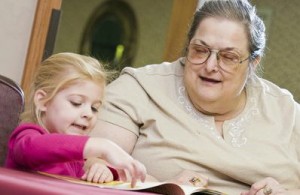Don Greiner, president of an Oklahoma nursing home chain, noticed a school district owned daycare center next door to the facility he was constructing at Jenks. Sensing an opportunity he approached the Jenks Public School to explore the possibility of a collaboration. Eventually this snowballed into something spectacular. The nursing home agreed to build two classrooms inside its facility and lease it out the school district at a nominal $1 per year.
Parents now drop their kids at the front door of the nursing home and the children snake through the nursing home to class. The classroom itself has glass doors that open into hallway and pane-free windows that allow children’s voices to float through the home.
As soon as class opened, many of the residents stopped by to see what was going on. One by one, several residents asked if they could help. The teachers quickly set up a program called Book Buddies. The program pairs a member of the retirement home with one of the children. The children read to the adults and the adults help them read for about 30 minutes several times a week.
The program has been a spectacular success with some remarkable results. Children here have been outperforming other children of the district in standardized reading tests. More than 70 percent are leaving the program at age five reading at third-grade level or higher. Parents are so pleased with the results that a lottery is now required for admissions as demand for the program is so strong.
Because of this success teachers began brainstorming how the collaboration between nursing home residents and children could be expanded. This is how Lise Morehouse describes the additional programs in her article:
Another key program is “shared study,” in which elders join small groups of kindergartners in hands-on activities. On the day of my visit, Grandma Irene rolled her wheelchair up to a round table where a handful of kids were creating books of fall leaves. She talked about making Christmas ornaments from leaves as a child, and throughout the activity helped students measure, color, describe textures, and make rubbings. Earlier in the month, students had made scarecrows while elders talked about growing up on farms; they worked together guesstimating the circumference of pumpkins. During a unit on senses, residents helped with taste tests.
According to kindergartner Liam, “We do activities, like trying new food. I tried a mint leaf and dark chocolate. I like school better with grandmas and grandpas.”
Site principal Suzanne Lair says shared study is developmentally appropriate for both groups. “Things like cutting and pasting with the kids helps the residents not lose those motor skills,” she adds.
Dramatic play is also important, as residents join pre-kindergarten students in enacting a scenario connected to the unit of study. Using props and costumes to set the scene — like Thanksgiving dinner, a vacation, a trip to the doctor’s office — the teacher gets the ball rolling, then kids, grandmas, and grandpas begin improvising. “This is all in the service of language development, interacting with vocabulary,” says Lair.
To promote connections between the generations, teachers look at class themes through the lens of “then and now.” In the My Classroom unit, for instance, students and elders compared how they traveled to school; in Healthy Habits, they discussed lunch choices and options from the past and today. Sometimes those discussions become big books created by the students and elders.
The remarkable thing is that the collaboration between the daycare center and the nursing home is not just benefiting the children. Something else is also going on. Medication levels in the nursing homes are plummeting and residents are living longer. It is as if the adults participating in the program have come back to life. Instead of whiling away their day they have a reason to get up in the morning and look forward to the day ahead. Because of this they are literally living longer.
The collaboration across generation is not something new. There is a mystical connection that happens across generations and from ancient times families have known about this. We have always leveraged this connection by allowing grandparents to spend time with their grandchildren. Unfortunately with the creation of nuclear families and migration to different towns, traditional family structures have broken down and this mystical connection is being lost. It is time that we use creative ideas as highlighted in this post to restore this mystical connection.
Related:
Senior Citizens Help Young Children with Reading — and Relationships
How to build intergenerational opportunities for learning
Watch the video/slide-show
Pictures from another intergenerational program
Credits:This has been written by Raj Shah and edited by Ketna Shah. The original inspiration for this post came from “The Element” by Ken Robinson. The picture is taken from the slideshow that accompanies Lise Morehouse’s article.


What a wonderful idea this is!!!……As a retired RN… and a grandmother myself…. This whole concept just brings tears to my eyes…..